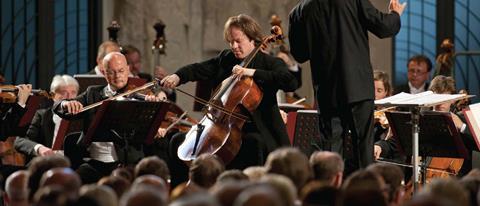The German cellist gets to grips with gut strings, Schumann, Elgar and Kabalevsky. From April 2016

Discover more Featured Stories like this in The Strad Playing Hub
This article was published in The Strad April 2016 issue
Last year at the Dresden Music Festival, the Festival Orchestra – consisting of early musicians from all over Europe –played Schumann’s Second Symphony. They were so fantastic that when they asked me if I’d play Schumann’s Cello Concerto with them there this May, there was no way I could say no.
The performance will be on gut strings, which I have never used before when playing this piece. I need to find a sound that is natural but also strong and expressive. In general, gut makes intimate passages easier to play, but it’s difficult to achieve the bigger sound required at other moments, such as the dramatic passages in the last movement.
I start my practice on my Stradivari, which is strung with steel. I always begin this way, as it’s more familiar. For about 15 minutes I play straight scales, broken chords and 6ths, to open my ears and get my hands warm. Then I go through some difficult parts of the Schumann: there are two runs in the exposition of the first movement that are awkward, so I play them slowly to make sure they are really secure. I do the same with the beginning of the last movement, and the last run in the coda, using a metronome. Then I bring everything up to speed, playing through each passage twice in tempo.
Once I have warmed up, I move on to my French cello – a Nicolas-François Vuillaume – strung with gut, so that I don’t have to change the strings on my Strad until nearer the performance. I explore its sounds and colours; sometimes I play a passage on the steel strings, then again on gut, to learn what I have to do differently.
The set-up on the Vuillaume is higher to accommodate the softer strings, and I use a lighter bow, but the main difference is bow speed: I have to move faster to make the instrument speak. I must think carefully about my vibrato and bow pressure too. Schumann often changes the colour and dynamic dramatically, with incredibly fast increases and decreases in intensity. The worst that can happen is that the music sounds too sanguine, balanced or normal, so I experiment to find the most effective bow speeds and contact points.
Playing on gut strings, I find that I can speed up my bow substantially while moving closer to the bridge, to dramatic effect. Using a lot of pressure with a slow bow works well on the steel strings, but the gut can’t take it. I watch the string vibrate with a wider amplitude as I move the bow faster and I can see that I am doing something right. Working with gut strings makes my bow arm feel alive: I have to be so much more varied when I play.
I am performing Kabalevsky’s Cello Concerto no.1 in Dresden at the end of April. The final third of the first movement has to be fast, dazzling, lively and effortless, and there are some octave shifts and double-stops that I have to repeat slowly, more quickly, and then in tempo every day, until I can forget what I am playing and focus on the music. The second movement is beautiful. As with the Schumann, I think about how to design my phrases and sound. Creativity is the most important thing here.
Next I move on to the Elgar Concerto, which I am playing in Montreal on 13 and 14 April. I grew up in East Germany, with a lot of Russian and German repertoire, and Elgar is not something that comes easily to me. But I adore this late-Romantic treasure and love playing it. I imagine a totally different sound world from Schumann, a heavier and more sustained sound, as though from a fairy tale.
Today I do some memory work on the first half of the last movement. I have seen some famous cellists having memory problems here, so each time I perform it I pray that I have practised it well enough! I play while imagining that the sheet music is in front of me, then try starting from the middle of a passage, which for me is always the test. If you attack from unexpected places then everything becomes less instinctive and more thoroughly ingrained.
I practise for around three hours. This is just the right amount for keeping a good level of focus, and I make good progress.
INTERVIEW BY PAULINE HARDING
This article was published in The Strad April 2016 issue
Listen: The Strad Podcast Episode #43: Jan Vogler on music festivals
Read: Masterclass: Jan Vogler on the Schumann Cello Concerto
Read more Featured Stories like this in The Strad Playing Hub
The number one source for playing and teaching books, guides, CDs, calendars and back issues of the magazine.
In The Best of Technique you’ll discover the top playing tips of the world’s leading string players and teachers. It’s packed full of exercises for students, plus examples from the standard repertoire to show you how to integrate the technique into your playing.
The Strad’s Masterclass series brings together the finest string players with some of the greatest string works ever written. Always one of our most popular sections, Masterclass has been an invaluable aid to aspiring soloists, chamber musicians and string teachers since the 1990s.
American collector David L. Fulton amassed one of the 20th century’s finest collections of stringed instruments. This year’s calendar pays tribute to some of these priceless treasures, including Yehudi Menuhin’s celebrated ‘Lord Wilton’ Guarneri, the Carlo Bergonzi once played by Fritz Kreisler, and four instruments by Antonio Stradivari.













































No comments yet